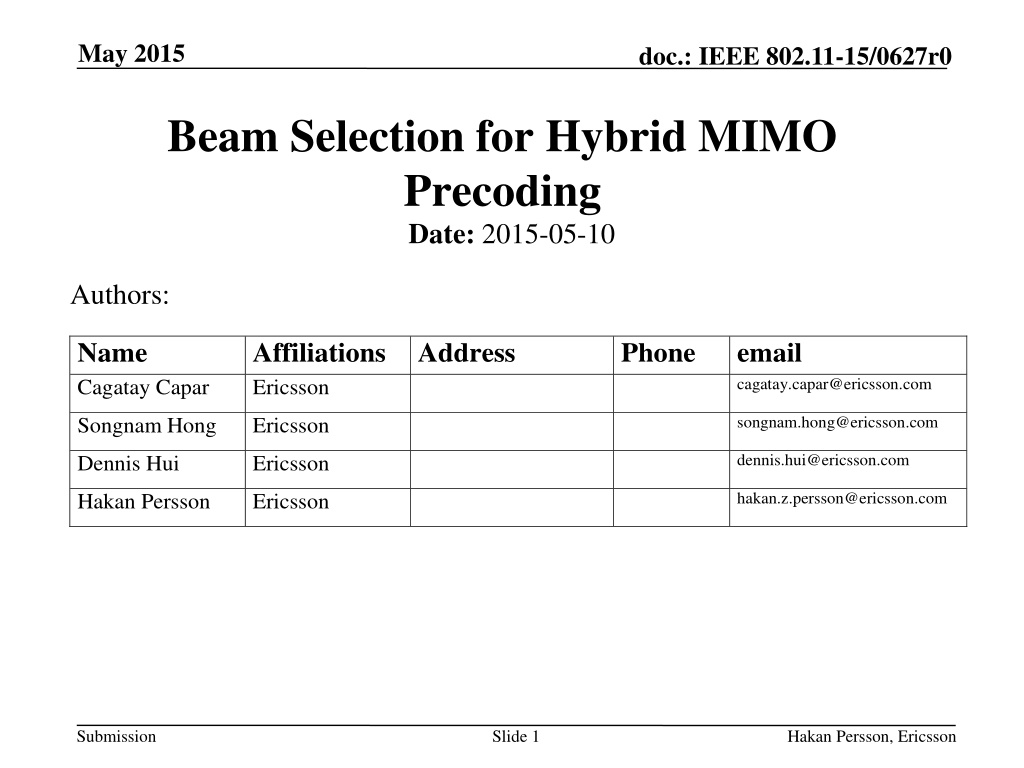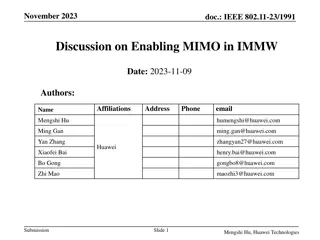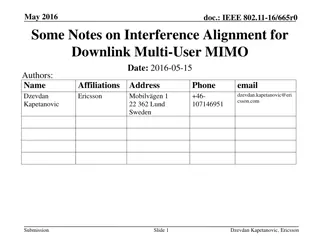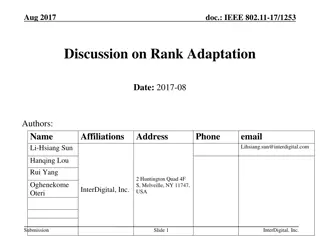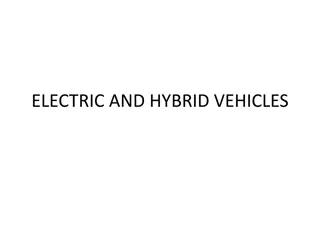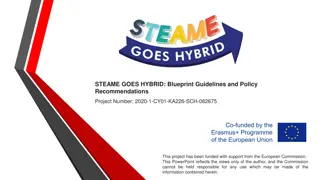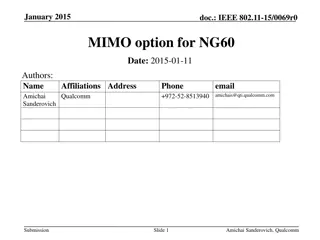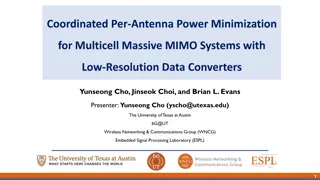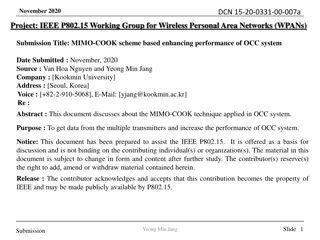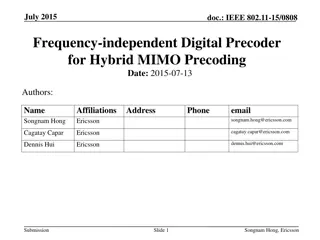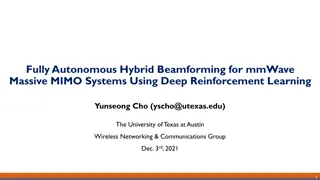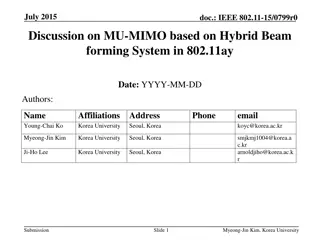Frequency-Independent Digital Precoder for Hybrid MIMO
Investigate the impact of suboptimal digital precoder choices on hybrid beamforming performance and feedback reduction. The presentation discusses two-stage precoding, optimal antenna phase shifts, codebook-based selection, and optimizing digital precoders for subcarriers.
Download Presentation

Please find below an Image/Link to download the presentation.
The content on the website is provided AS IS for your information and personal use only. It may not be sold, licensed, or shared on other websites without obtaining consent from the author.If you encounter any issues during the download, it is possible that the publisher has removed the file from their server.
You are allowed to download the files provided on this website for personal or commercial use, subject to the condition that they are used lawfully. All files are the property of their respective owners.
The content on the website is provided AS IS for your information and personal use only. It may not be sold, licensed, or shared on other websites without obtaining consent from the author.
E N D
Presentation Transcript
May 2015 doc.: IEEE 802.11-15/0627r0 Beam Selection for Hybrid MIMO Precoding Date: 2015-05-10 Authors: Name Cagatay Capar Affiliations Ericsson Address Phone email cagatay.capar@ericsson.com songnam.hong@ericsson.com Songnam Hong Ericsson dennis.hui@ericsson.com Dennis Hui Ericsson hakan.z.persson@ericsson.com Hakan Persson Ericsson Submission Slide 1 Hakan Persson, Ericsson
May 2015 doc.: IEEE 802.11-15/0627r0 Abstract In this presentation, beam selection for hybrid precoding for 11ay is investigated. Our goal is to see if beams selected are changed according to MIMO modes (e.g., max number of streams). Via simulation results for a living room model, we show that optimal beams can be quite different according to the max number of streams. Therefore, it might not be a good approach to select beams independent of MIMO modes. This observation implies that the optimal number of streams may change (e.g., SINR is changed) before retraining, receiver may feed back multiple sets of optimal beam indices (each suitable for a particular number of streams). Submission Slide 2 Hakan Persson, Ericsson
May 2015 doc.: IEEE 802.11-15/0627r0 Outline Introduction Hybrid Beamforming Motivation Optimal Beam Selection Simulation Results Summary and Conclusions Submission Slide 3 Hakan Persson, Ericsson
May 2015 doc.: IEEE 802.11-15/0627r0 Introduction MIMO is considered for 11ay to improve data rates and reliability [1]. Different MIMO modes can be employed depending on the environment/application [2]. Submission Slide 4 Hakan Persson, Ericsson
May 2015 doc.: IEEE 802.11-15/0627r0 Hybrid Beamforming RF RF H BB BB RF RF 1) Coarse Beamforming: Optimal sectors or antenna weights are selected. 2) Fine Beamforming: Baseband precoding/combining is done. Conventional approach: After coarse beamforming, one set of beams are selected to form the effective (baseband) channel matrixH to be used for the fine beamforming stage. Once H is known, traditional MIMO techniques apply. Will this give the best performance for all MIMO modes? Submission Slide 5 Hakan Persson, Ericsson
May 2015 doc.: IEEE 802.11-15/0627r0 Motivations In some scenarios, it can be advantageous for the transmitter to know the optimal beams for different MIMO modes. For example, when SINR changes abruptly between beam selection sessions, MIMO mode can be switched without retraining, which is time consuming. We show that optimal beams can be different according to the MIMO mode. The MIMO mode we consider here is the max number of streams, ??????? . ??? Submission Slide 6 Hakan Persson, Ericsson
May 2015 doc.: IEEE 802.11-15/0627r0 MIMO Mode-specific Beam Selection RF RF H BB BB RF RF 2x2 MIMO example: Beams are selected from a codebook. i1 : beam index for the first transmit array i2 : beam index for the second transmit array j1 : beam index for the first receive array j2 : beam index for the second receive array H=H(i1, i2, j1, j2) - Ideally, the set of all possible H s should be checked to find the optimal beams for a considered MIMO mode. Submission Slide 7 Hakan Persson, Ericsson
May 2015 doc.: IEEE 802.11-15/0627r0 Optimization Problem Finding optimal beam indices to maximize sum- throughput as ?? subcarriers are used and ???1,?2,?1,?2 denotes the effective baseband channel matrix at subcarrier f for beam indices ?1,?2,?1,?2. Optimal baseband precoding (using SVD) is applied with joint water filling across subcarriers and layers subject to total power constraint ??????. Baseband precoding is done per subcarrier. Submission Slide 8 Hakan Persson, Ericsson
May 2015 doc.: IEEE 802.11-15/0627r0 Simulation Details Receiver fixed at one location. Several transmitter locations tested. Both transmitter and receiver have two antenna arrays 2x2 MIMO. Antenna arrays are 1x8 linear arrays. For each transmitter location, full channel matrix (16x16) is generated by ray tracing. Studio apartment room plan: Rx 3 1 Tx 2 4 5 Submission Slide 9 Hakan Persson, Ericsson
May 2015 doc.: IEEE 802.11-15/0627r0 Simulation Details Optimal beam indices from the beam codebook (of size 16) are found by exhaustive search for both one- stream and two-stream mode, (i.e., ??????? ??????? = 2, respectively, for the constraint in the optimization problem.) Studio apartment room plan: ??? = 1, and Rx ??? 3 1 For each location, three rate values are calculated: 1) Rate achieved with optimal beams for two- stream mode, 2) Rate achieved with optimal beams for one- stream mode, 3) Rate achieved with sending one stream over the optimal beams for the two-stream mode. 2 4 5 Results are generated for varying total transmit power values. Submission Slide 10 Hakan Persson, Ericsson
May 2015 doc.: IEEE 802.11-15/0627r0 Simulation Results [i1*, i2*, j1*, j2*] ??????? [1,9,1,1] [1,9,1,1] [1,9,1,1] [1,9,1,1] [1,9,1,1] [1,9,1,1] [1,9,1,1] [1,7,1,11] [1,7,11,1] [1,7,11,1] [1,7,11,1] [1,7,11,1] [1,7,11,1] [1,7,11,1] [1,7,11,1] [1,7,11,1] [i1*, i2*, j1*, j2*] ??????? [1,9,1,1] [1,9,1,1] [1,9,1,1] [1,9,1,1] [1,9,1,1] [1,9,1,1] [1,9,1,1] [1,9,1,1] [1,9,1,1] [1,9,1,1] [1,9,1,1] [1,9,1,1] [1,9,1,1] [1,9,1,1] [1,9,1,1] [1,9,1,1] Total Power (dBm) -15 -13 -11 -9 -7 -5 -3 -1 1 3 5 7 9 11 13 15 ??? ??? = 2 = 1 1 1 9 7 11 11 1 1 Optimal beams for two-stream mode change at a certain point, while optimal beams for one-stream mode remain the same. There is a performance penalty for using suboptimal beams. In low SNR, the two modes achieve the same rate since the two-stream mode also chooses one stream operation by allocating all power to one of the eigenchannels. Submission Slide 11 Hakan Persson, Ericsson
May 2015 doc.: IEEE 802.11-15/0627r0 Simulation Results 1 2 Submission Slide 12 Hakan Persson, Ericsson
May 2015 doc.: IEEE 802.11-15/0627r0 Simulation Results [i1*, i2*, j1*, j2*] ??????? [14,8,4,4] [i1*, i2*, j1*, j2*] ??????? [14,8,4,4] Total Power (dBm) -15 -13 -11 -9 -7 -5 -3 -1 1 3 5 7 9 11 13 15 ??? ??? = 2 = 1 [14,8,4,4] [14,8,4,4] [14,8,4,4] [14,8,4,4] [14,8,4,4] [14,8,4,4] [14,8,4,4] [14,8,4,4] 5 [14,8,4,4] [14,8,4,4] [14,8,4,4] [14,8,4,4] [14,8,4,4] [14,8,4,4] [14,8,4,4] [14,8,4,4] [14,8,4,4] [14,8,4,4] [14,8,4,4] [14,8,4,4] [14,8,4,4] [14,8,4,4] [14,8,4,4] [14,8,4,4] [14,8,4,4] [14,8,4,4] [14,8,4,4] [14,8,4,4] [14,8,4,4] [14,8,4,4] This time, due to poor spatial properties of the channel, both modes pick the same beams for all total transmit power values. In low SNR, the two modes achieve the same rate since the two-stream mode also chooses one stream operation by allocating all power to one of the eigenchannels. Submission Slide 13 Hakan Persson, Ericsson
May 2015 doc.: IEEE 802.11-15/0627r0 Summary and Conclusions We observe that optimal beams can be different according to MIMO mode, e.g., maximum number of streams. In some situations, it is useful for the transmitter to know the optimal beams for different MIMO modes. Hence, receiver may need to feed back multiple sets of beamforming indices (each for one MIMO mode). Further study may be required for the design of feedback in 11ay. Submission Slide 14 Hakan Persson, Ericsson
May 2015 doc.: IEEE 802.11-15/0627r0 References 1. 11-14/0606r0, Next Generation 802.11ad: 30+ Gbps WLAN 2. 11-15/0334r1, MIMO Framework 3. 11-15/0356r0, MU-MIMO schemes for NG60 Submission Slide 15 Hakan Persson, Ericsson
